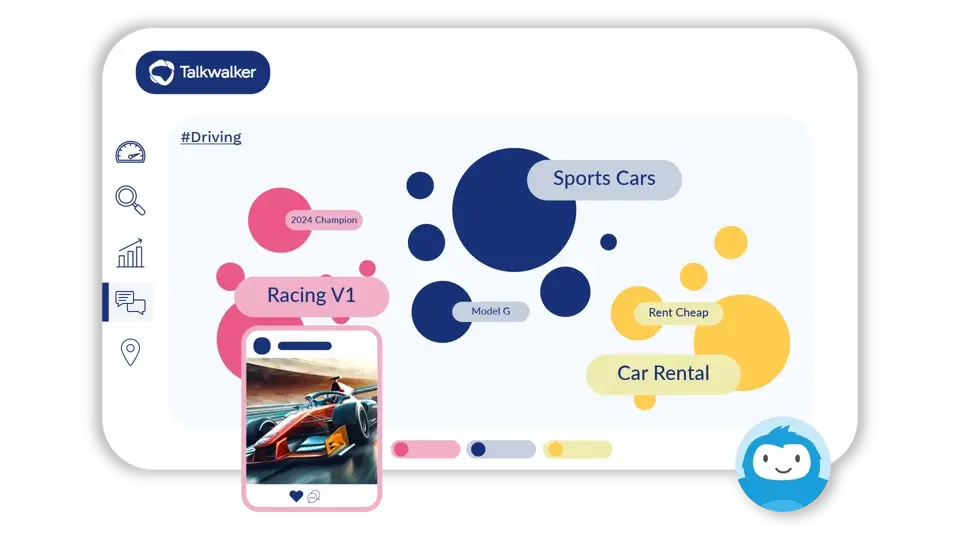Crisis management
7 social media crisis examples (and tips for speedy mitigation)
Learn how to prevent and manage a social media crisis with real examples and tactical tips for protecting your brand reputation.
October 24, 2025
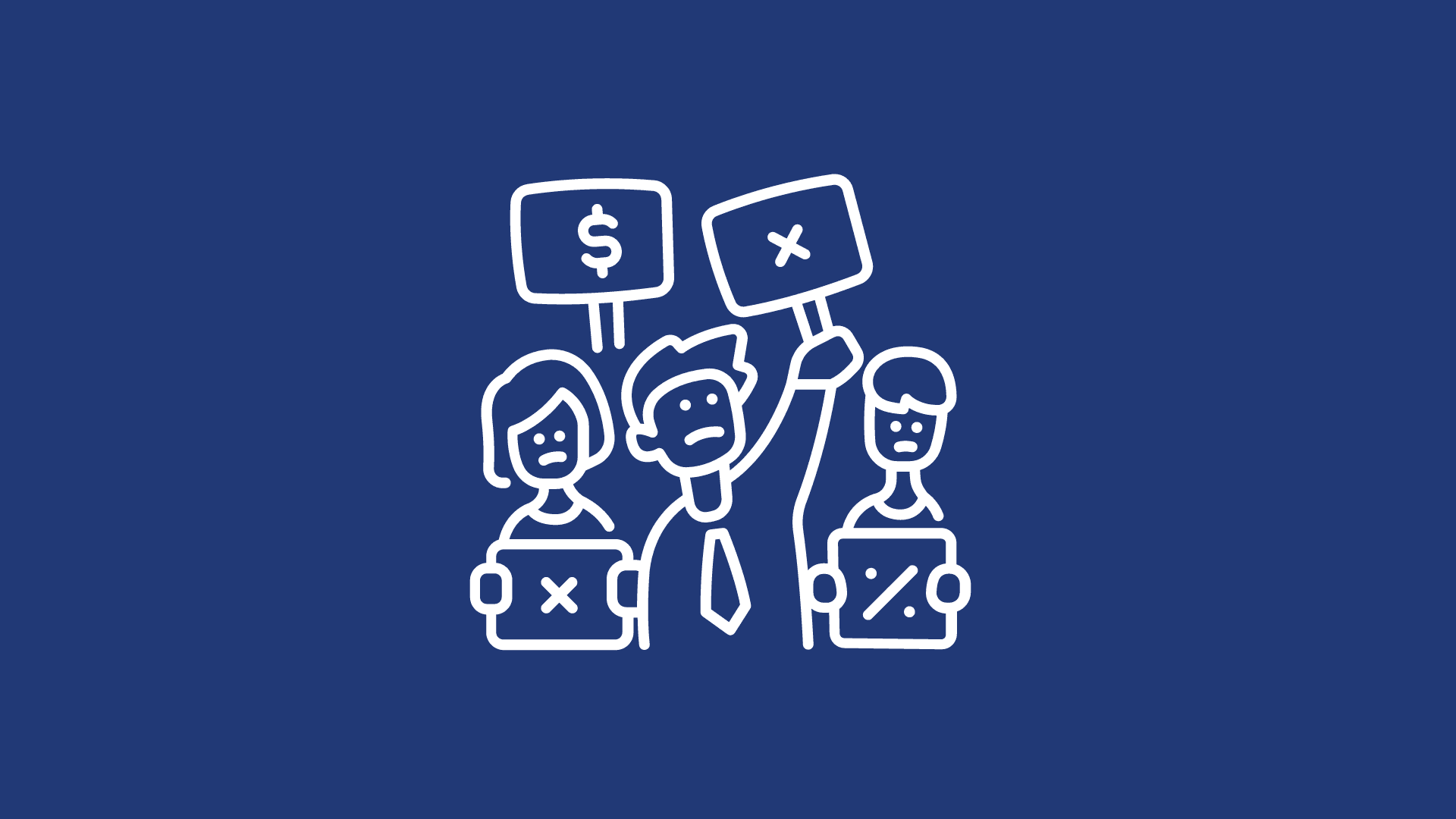
Things move fast on social media. A simple misstep can snowball into a crisis in no time at all. The best way to defend against a full-blown social media crisis is to set up a social monitoring strategy so you can catch and correct a problem before it gets out of hand.
Not every social media crisis is preventable, but every disaster offers a chance to learn.
In this guide, we look at seven examples of social media crises and the lessons they teach us.
We also dive deep into potential crisis migration techniques and how to access actionable insights to manage a crisis in real time.
What is a social media crisis?
A social media crisis happens when negative comments and content about your brand rapidly spread online.
It can start with a poorly perceived post, ad, strategy, or customer complaint. Sometimes, it can start with misinformation about your brand or some other external situation.
These situations can seriously damage your sales numbers, brand reputation, and customer relationships if not addressed quickly.
What is not an example of a social media crisis?
Not every negative moment on social media is a full-blown social media crisis – especially if you catch it early. Here are some unpleasant things you may have to deal with while managing a social media account that so not qualify as a social media crisis (although they still need to be addressed):
A small number of customer complaints or negative reviews
While you should respond to people who have had a negative experience with your brand and try to make it right, you can never please everyone. A small number of complaints, direct messages, or bad reviews is an expected part of doing business.
However, complaints or negative reviews have the potential to turn into a social media crisis if not addressed, especially if they’re posted by someone with a large following. A large number or steeply increasing number of complaints can also be a crisis, but a small number is more of a customer service issue.
Rude or profane comments on your social media posts
Again, these are an expected part of working with social media, where people are not always at their most polite. Rather than a social media crisis, this is more of a content moderation issue.
Use the automated keyword filters built into most social platforms to block the most objectionable content, and ensure your social team keeps an eye on the rest.
Negative announcements from your company
Odds are, your company will have some negative news at some point: layoffs, lower-than-expected earnings, a product recall, or price increases.
Negative news is in itself not a social crisis – although it has the potential to turn into one if not handled correctly. Make sure you have a plan to stay ahead of the conversation, including any potential misinformation, before you make your announcement.
7 social media crisis examples
Let’s look at some real-life social media crisis management examples to see what lessons can be learned.
1. Cheating Astronomer execs go viral after Coldplay kiss cam
On July 16, 2025, two executives from the tech company Astronomer were caught on the Kiss Cam at a Coldplay concert. One of them, the CEO, was married to someone else. The video went viral after the two leapt apart when caught on screen, and frontman Chris Martin said he hoped the band “didn’t do something bad.”
Since most people had never heard of Astronomer, their first introduction to the brand was one that cast corporate culture in a very questionable light. To make matters worse, a fake statement from the CEO started circulating on social media in the days following the event.
Astronomer’s response:
The two execs were placed on leave and both soon resigned.
Astronomer shared social posts about their commitment to “values and culture” and their next steps for the CEO role on July 18.
On July 19, the company shared a lighthearted video that subtly acknowledged the controversy while taking advantage of the increased attention to showcase what the company actually does. The spokesperson? Gwyneth Paltrow, ex-wife of Coldplay’s lead singer.
After the Paltrow video, Astronomer social media channels returned to their regular content about data collection.
Lessons learned:
Employee behavior matters. This is especially true for executives, but it’s a good idea to have a social media policy in place for all employees.
It’s critical to have a social media crisis communication plan in place so you can respond quickly. If the brand had put out their own response faster, the fake statement would not have gained traction.
A creative public relations campaign can help mitigate the fallout of a social media crisis. The Paltrow video got 150,000 likes and 25,000 shares on X, and nearly 69,000 likes on Instagram.
2. Sydney Sweeney American Eagle campaign controversy
In summer 2025, American Eagle launched a denim campaign starring Sydney Sweeney with the tagline “Sydney Sweeney has great jeans.” The ads were set up as a play on words with jeans/genes. In one version of the ad Sweeney says, “Genes are passed down from parents to offspring, often determining traits like hair color, personality, and even eye color. My jeans are blue.”
The campaign received significant negative attention, with some saying this type of wordplay was not appropriate in a campaign featuring a white, blonde, blue-eyed woman. Social media users in particular called it tone-deaf. But it also received significant positive attention from people (including the president) who delighted that the ads were not “woke.”
This one has a different outcome than most examples of social media crises. While there was a social media firestorm, the products featured in the ad sold out, and the company’s stock price increased by 10%.
American Eagle’s response:
American Eagle rejected the negative commentary and leaned into their campaign. Their only comment was a post on Instagram saying it “is and always was about the jeans.”
Lessons learned:
Negative publicity doesn’t necessarily mean you have to backtrack. Leaning into your decision can be a valid course of action, but you need to think about the long-term impact and potential reputational damage. AE sold a lot of jeans and won points with one consumer group but alienated another.
3. Cracker Barrel’s quick reversal of their logo change
In August 2025, Cracker Barrel Old Country Store launched a new, simplified logo intended to be more modern and to work better on digital platforms. It was part of a larger rebrand that modernized the restaurants, too.
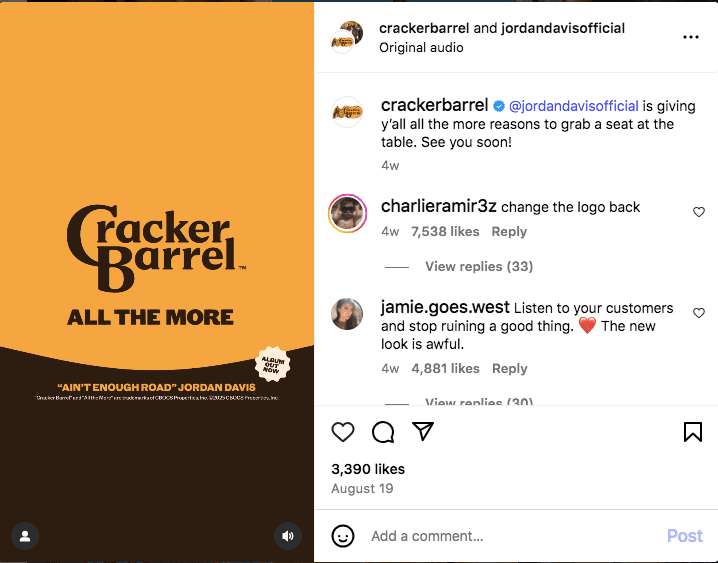
Source: @crackerbarrel
Customers were not happy. They saw the whole thing as taking the soul out of Cracker Barrel and making it another generic chain restaurant. The conversation on social media platforms was almost uniformly negative feedback, and the stock price dropped 7 percent.
Cracker Barrel’s response:
Initially, the company tried to save their rebranding efforts by telling customers, “While our logo and remodels may be making headlines, our bigger focus is still right where it belongs… in the kitchen and on your plate.
This approach didn’t last long. Within the week, the company listened to its customers and reversed its rebrand.
Lessons learned:
Even on digital platforms, modern is not always better. It’s important to stay true to your brand values.
Market research is important before a major change. Cracker Barrel only tested the restaurant remodel in four out of 660 locations. A larger sample size would likely have revealed that customers were not on board with the plan before they announced the logo change.
4. British Museum’s misguided meme
In March 2024, the British Museum posted a meme that quickly sparked social media outrage.
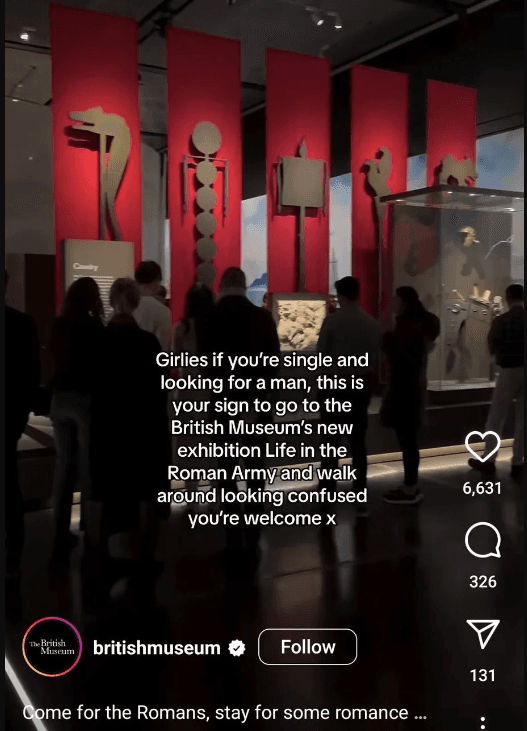
Source: Art News
The post suggested "girlies" visit their Roman Army exhibition to find men by "looking confused." It was meant to riff on a TikTok trend about men pondering the Roman Empire. But social media users, especially academics, criticized the post as sexist and unprofessional.
British Museum's response:
The museum initially defended the post as a joke about "mansplaining" in the comments.
They claimed they weren't suggesting women "need to look for dates or pretend to be stupid."
After continued backlash, they deleted the posts from Instagram and TikTok.
The museum then issued an official public apology for the misstep.
Lessons learned:
Don't try to be "trendy" at the expense of your company's reputation.
Stay true to your brand voice.
Consider how different audience segments might perceive your content.
Have a clear and thorough review process for social media posts.
When you make a mistake, apologize.
Remember that attempts at humor can easily backfire.
Be cautious when adapting trends from one platform (TikTok) to another (Instagram).
5. Delta’s uniform policy controversy
In July 2024, Delta faced a social media backlash over a uniform policy. Two flight attendants were spotted wearing small Palestinian flag pins on their uniforms.
A social media user posted photos, calling them "Hamas badges" and asking what passengers should do.
Delta's social media team responded by saying they'd be "terrified as well." Of course, the internet exploded, accusing Delta of anti-Palestinian bias and calling for boycotts.
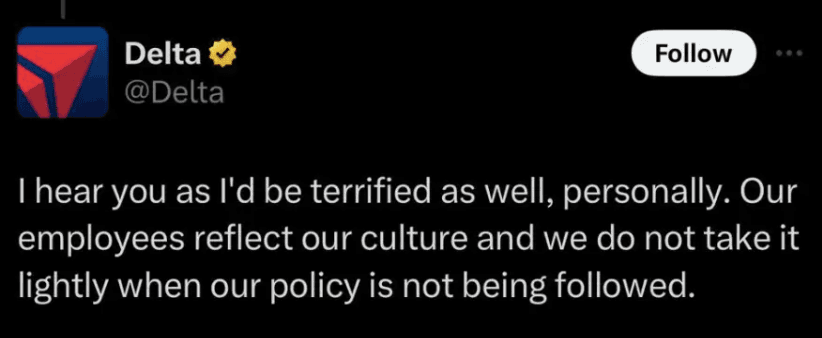
Source: New York Post
Delta's response:
They deleted the initial inflammatory response and apologized.
The employee behind the social media blunder was removed from Delta's social channels.
Delta introduced a new policy: no pins representing any country except the U.S.
They claimed this was to ensure a "safe, comfortable welcome environment for all."
Critics saw this as an overreaction and as potentially silencing workers.
Lessons learned:
Think before you post, and create specific guidelines and a thorough review process for your social media team members. Delta's response made the actual crisis.
Staying neutral is tricky business. Delta's attempt at damage control didn’t make the situation better.
Stand by your people. Delta faced criticism for not supporting the photographed flight attendants.
Address the root cause, not just the symptoms. Changing policy without tackling underlying issues is not enough.
6. Kellogg's CEO's "Cereal for Dinner" controversy
In February 2024, Kellogg's CEO Gary Pilnick suggested families eat cereal for dinner to save money during a CNBC interview. Pilnick was promoting Kellogg's "cereal for dinner" campaign amid rising food prices.
Social media exploded, accusing Pilnick of being out of touch with economic realities.
Critics compared his comments to Marie Antoinette's infamous "let them eat cake” and the hashtag #BoycottKelloggs started trending on TikTok.
Kellogg's response:
The company initially stayed quiet, and this lack of response allowed the backlash to grow unchecked.
Lessons learned:
Context is essential. Business-speak doesn't always translate well to the general public.
Silence isn't always a good idea. Kellogg's lack of response caused the situation to spiral.
Make sure your marketing campaigns and leadership are on the same page.
Sometimes, the CEO isn't the best spokesperson for sensitive topics.
Consider the long-term impact of your response (or lack thereof).
7. Bud Light's Dylan Mulvaney partnership backlash
In April 2023, Bud Light partnered with transgender influencer Dylan Mulvaney for a promotional campaign.
This led to significant controversy and business impact. The partnership faced criticism from conservative figures, quickly escalating into calls for a boycott.
Social media amplified the controversy, affecting brand perception and sales.
Bud Light's U.S. sales dropped by about 15% in Q2 2023, and the brand temporarily lost its position as America's best-selling beer.
Bud Light's response:
CEO Brendan Whitworth released a statement that seemed to distance the company from the partnership.
Two executives were reportedly put on leave.
The company's response was perceived as not fully supporting their initial decision and partner. This created even more backlash. Now both sides of the debate were mad about it.
Lessons Learned:
Consistency in brand values is essential, especially during controversies.
Strong support for partnership decisions can reinforce brand integrity. Compare this response to American Eagle’s reaction to the controversy over the Sydney Sweeney ads.
Crisis management should prioritize standing by intentional, inclusive marketing choices.
Transparent communication with all stakeholders is essential during controversies.
Brands need to be prepared for potential backlash when engaging with socially progressive issues.
Essential tips for social media crisis mitigation
Monitor brand mentions in real-time
Crisis management and social media monitoring tools are vital for this.
By proactively using social media listening to know what consumers are saying about your brand, competitors, and industry, you can:
Be alert to any potential crises before they escalate
Gather real-time insights to shape your response and crisis management strategy
Understand the sentiment and concerns of your audience
Know which groups and communities are most affected
Identify key influencers and channels driving the conversation
Be fast and transparent
A fast response is crucial when a crisis hits, as quick, thoughtful responses can help mitigate damage. Ideally, you need to spot the issue within minutes and respond within hours—not days.
That said, your crisis communication needs to be clear and accurate. Provide accurate information (and correct misinformation), address concerns, and demonstrate that you are committed to resolving the issue. If you made a mistake, own up to it and share your plan for making it right. Apologize. You need to be open and honest to rebuild brand trust.
If you don’t have an immediate solution, it’s okay to say so. It’s still important to acknowledge the crisis as soon as possible and ensure the affected groups know you’re working on it.
Have a crisis management plan in place
The best way to ensure you can respond quickly is to have a plan in place before you face a full-blown crisis. Start by defining what a crisis looks like. Define sentiment and key metric thresholds, and tie them to automated alerts.
Define your crisis response team and provide clear escalation and approval plans. Internal communication is very important. Everyone needs to know exactly who’s in charge and what their role is in the response.
If you know things are happening that could negatively address your brand, like changes in the industry or an upcoming negative announcement, you can also create key messaging in advance for your team to lean on.
Pause scheduled content
When you’re actively managing a crisis, you do not want a scheduled comedic post going live on your feed. In fact, you don’t want anything going live on your feeds that is not part of the orchestrated response to the crisis.
If you schedule your social content with a tool like Hootsuite, you can pause all scheduled content with just a couple of clicks. That content still exists in draft form, so you can revive it when the time is right.
Watch for misinformation
In a crisis, it’s hard enough to deal with what’s actually happening. Misinformation thrown into the mix can make things exponentially worse.
As part of your monitoring efforts, track relevant keywords and hashtags to keep an eye out for false claims. Then, create content that corrects the record with verified facts and details. Avoid the impulse to engage with negative voices that are just looking for a fight.
Debrief once the crisis has passed
A crisis may feel like chaos while it’s underway. But everything that happens during this heightened time is a lesson for the future.
Once everything is sorted, get key stakeholders together to talk about what happened and how you can prevent it from happening again. (Or what you will do differently if it does happen again.)
This is a good time to review and update your social media crisis management plan.
How to get ahead of social media crises with Talkwalker
Use real-time monitoring to catch a crisis in its earliest stages
You need to know what people are saying about your brand before a crisis gets out of hand. Talkwalker lets you see what people are saying about you on social media, news sites, forums and review sites, blogs, and more in real time.
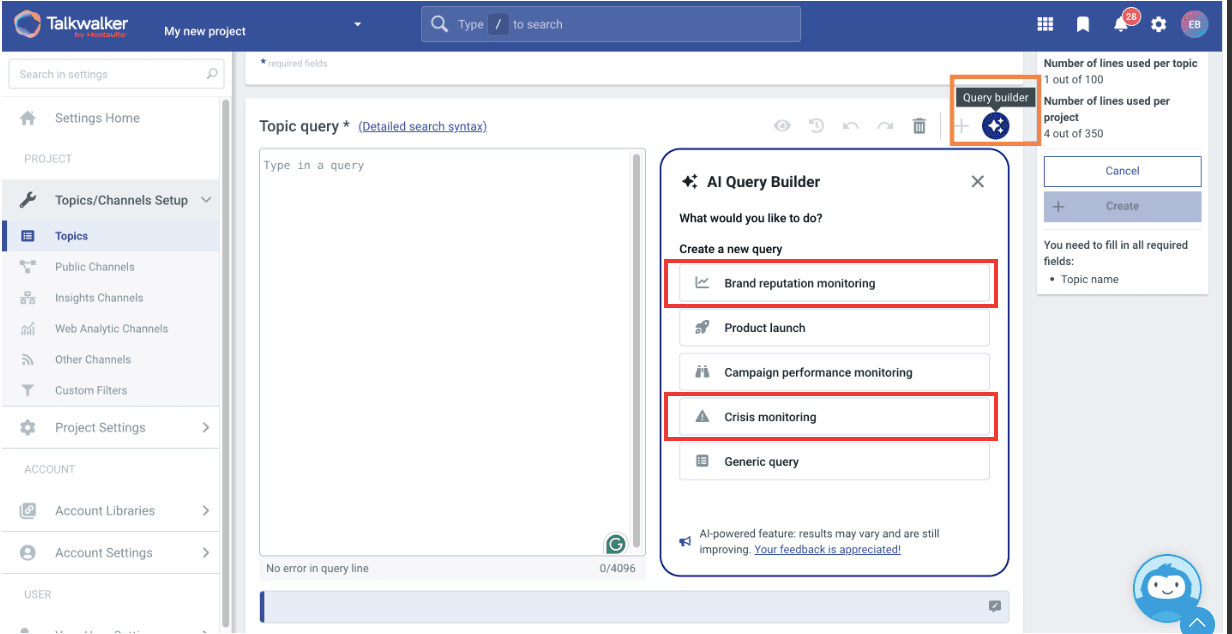
This comprehensive data coverage can help you spot a crisis brewing while it’s still only a subject of conversation in niche communities, so you can take action before things escalate to a wider audience.
It also ensures you know exactly what people are saying, so you can craft a response that best addresses their concerns and avoid amplifying rumours or misinformation.
Talkwalker’s AI Query Builder helps make sure you capture the full scope of the conversation. Use the Brand Reputation query builder to help you keep an eye on things before a crisis emerges. If you’re already dealing with a crisis, create a new query using the Crisis monitoring option.
In both cases, you just enter the brand name and describe what you want to monitor, and the AI Query Builder will create a search for you that you can monitor in real time.
Gauge the impact of the crisis (and your response) with sentiment analysis
A downward trend in the public sentiment about your brand can be an early indicator of a brewing crisis. Once a crisis is already underway, sentiment analysis is critical to help you understand the full impact of what’s happening and gauge response to any corrective actions you take.
For example, here’s a Talkwalker sentiment analysis for the brand American Eagle, showing the dip in sentiment around the release of the Sydney Sweeney ad campaign. You can see that the brand quickly got things back under control, in part because they backed their spokesperson and clarified the intent of their messaging.

Use alerts for proactive crisis management
You can set up AI-predictive alerts and smart spike detection to identify spikes in negative sentiment, irregular activity, and sudden increases in mentions. This acts as an early warning system to let you know when things are changing fast.
For example, this Talkwalker widget shows the number of mentions for American Eagle.

That spike in July would trigger an automated alert if brand monitoring was set up.
Benchmark against competitors in an industry-wide crisis
Sometimes a crisis is larger than your brand. If it’s an industry or economy-wide type of crisis, knowing how your competitors are doing can help you evaluate the effectiveness of your own response.
You can check your competitors’ KPIs against yours in the moment or over the duration of the crisis to get a sense of how you’re faring.
For example, here’s a real-time snapshot of the sentiment for Coke vs. Pepsi. If this were a crisis moment, Coke would want to analyze Pepsi’s social media presence and strategy to see why they have less negative sentiment.
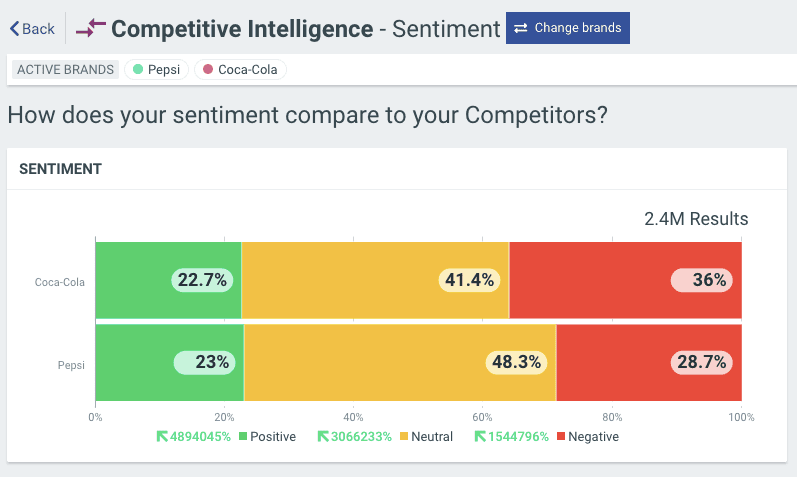
Identify the loudest voices in the conversation
It’s important to understand whether a social media crisis is being driven by many voices or just a few. Understanding who the key opinion influencers are allows you to focus your outreach where it will have the most effect.
For example, here’s who’s driving the conversation about Cracker Barrel’s logo change, sorted by greatest engagement.
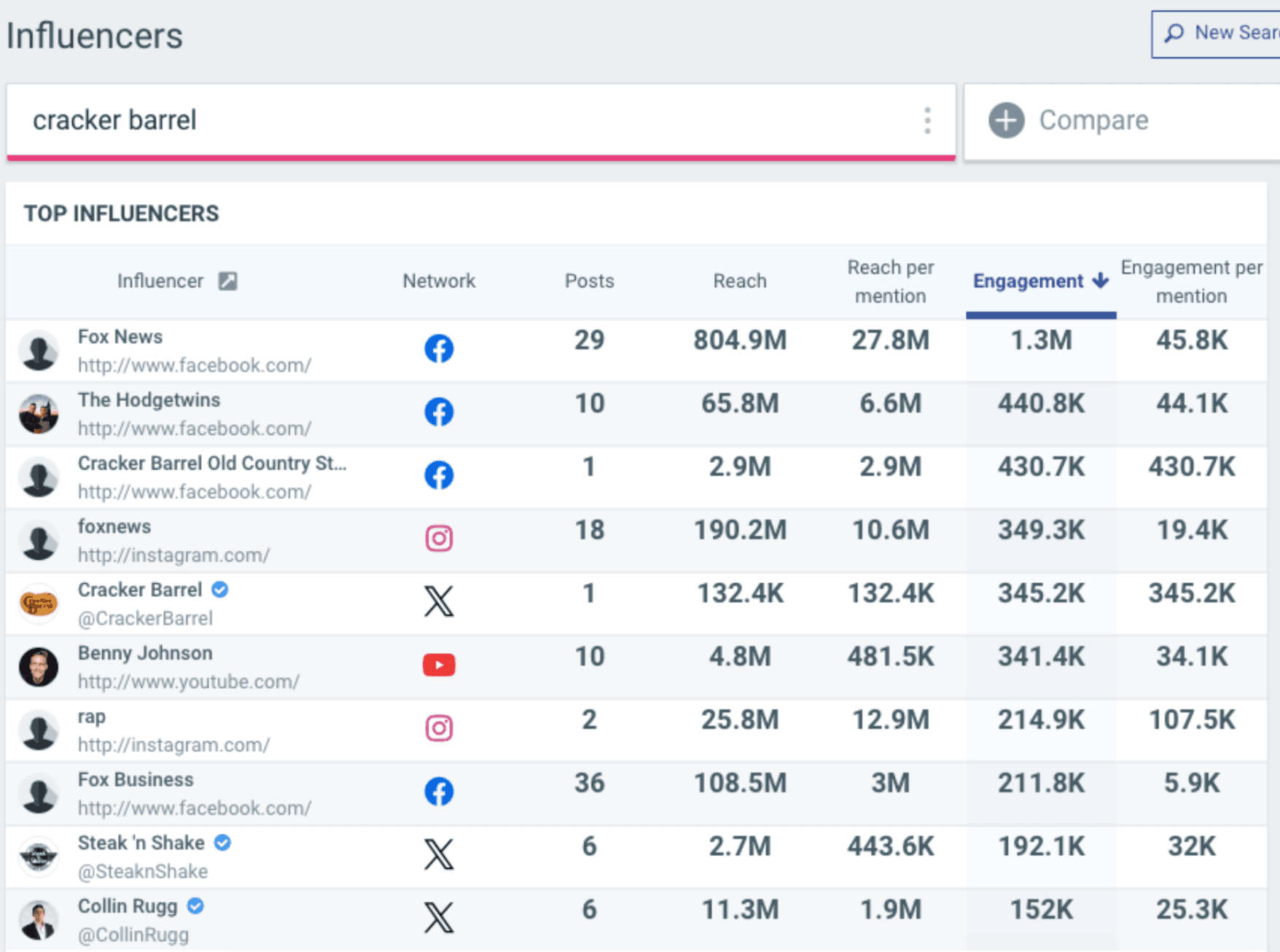
Create a crisis management dashboard
A crisis management dashboard is a critical tool if you ever have to put your crisis management plan into place. Talkwalker has a built-in dashboard called the Crisis IQ App. It’s designed to help you monitor, analyze, and manage a crisis in real time.
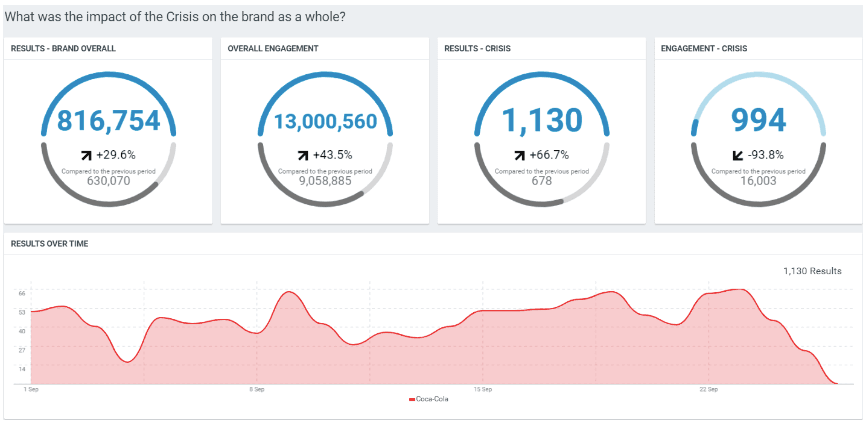
To set up your Crisis IQ App, select your topic (the specific crisis or issue), then apply filters to focus on relevant aspects. You can also choose to focus specifically on social media, rather than on news sites and other sources.
Within the app, you’ll see how widely the crisis is being discussed (and where), how it’s affecting your brand health
This app is built to provide actionable insights during a crisis, so you can make informed strategic decisions and protect your brand’s reputation.
Ready to protect your brand before the next crisis hits? With Talkwalker, you can spot early warning signs, monitor sentiment in real time, and respond with data-driven confidence. Turn every social media crisis into an opportunity to strengthen trust. Book a demo today to start monitoring your brand with Talkwalker.
